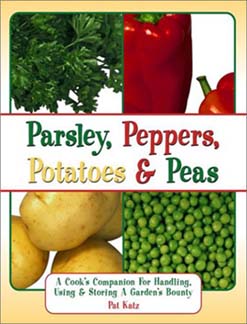 Canning
comfrey? Drying dandelions? Freezing figs? Preserving peaches? If so,
you might want to turn to the latest edition of Pat Katz's reference
for those fortunate people who cannot only grow a bounty of foodstuffs,
but also have the time to prepare and preserve them.
Canning
comfrey? Drying dandelions? Freezing figs? Preserving peaches? If so,
you might want to turn to the latest edition of Pat Katz's reference
for those fortunate people who cannot only grow a bounty of foodstuffs,
but also have the time to prepare and preserve them.
More than
10 years of writing the Countryside Journal's food column and
decades of personal experience in the garden and the kitchen have developed
Katz into a capable conveyor of everything your grandmother knew and
a little more. Her writing is simple and approachable, giving equal
weight to both technical food safety issues and practical down-home
advice.
The content of
Katz's first book, 1988's The Craft of the Country Cook from A to
Z, was reduced over medium heat to half the original volume in 1997
when Hartley & Marks published The Kitchen Gardener's Companion:
An A-Z Encyclopedia for Using the Food That You Grow, which has
been directly converted by Gramercy into the 2002 edition.
The book purports
to contain "all the basics for the kitchen gardener, including
canning, pickling, freezing and cooking, as well as a smattering of
classic and unique recipes". Over 70 types of fruit and vegetables
have their own entries. There are general sections on items including
nuts and herbs and informative essays on nine major preparation methods.
The featured edibles include all the apple and carrot mainstays of North
American temperate gardens, many rarer garden products such as kohlrabi
and quince, and some downright puzzlers, like seaweed. Everything I
grow on my farm in northwest Washington was included, but gardeners
from warmer climates might be disappointed with the omission of citrus
fruits, avocados, and other fun-in-the-sun produce. In addition to the
food entries, there are informative essays on nine major preparation
methods.
All of the content
is organized alphabetically, which works well for the fruits and vegetables,
but is a questionable format for the essays on broader topics such as
canning, which is sandwiched uncomfortably between cabbage and carrots.
The table of contents is handy for someone new to the book, if a trifle
redundant for the seasoned user due to the alphabetical content. The
index of recipes and food ideas is a useful addition for the cook who
does not want to have to browse the entire apple section to find the
apple beer instructions. The subject index is inconsistent; looking
up "cold storage" leads you to the main essay on this preservation
method, as well as the apples and cabbage entries, but does not mention
the four paragraphs on cold storage in the potato entry. Cross-references
within the text, however, are delightfully plentiful.
The length of entries
for individual fruits and vegetables ranges from 2970 words on the common
and useful "Corn, Dry", to 495 words for "Swiss Chard".
"Canning" merits 6930 words while "Steam Cooking"
is covered in 1485 words. Contents of entries vary widely depending
on the nature of the crop. Usually included is vague information on
different varieties, as well as details on handling, canning, freezing,
drying, and a smattering of recipes and ideas for use. I found the essays
on preparation methods to be very practical overviews for both novice
and experienced gardener cooks. The canning section, for example, goes
into detail on canning methods, equipment, temperatures, times, concerns
such as botulism, and has a brief list of references.
The print is as
large as a cucumber seed, the lines are well spaced, and font variations
are used judiciously, which makes for easy reading of the main text.
The large subject title on the upper outside edge of each page directly
above the page number facilitates quick location of each entry. Illustrations
are minimal: Two small line drawings of leaves are repeated throughout
the work for decoration and 10 black and white explanatory diagrams
are used. Unfortunately, each essay has a considerable portion of its
content presented in a continuous series of sidebars throughout its
section and occasionally starting in the previous section and continuing
into the following section. This is highly distracting, makes for a
much less attractive page, creates unnecessary difficulties while trying
to find specific information, and forces the reader to follow two streams
of text at once, which is frustrating enough to make you want to crawl
into a root cellar and hide.
This book contains
a plentitude of practical information, sensibly broaching the divide
between gardening and cooking references, but is redundant if either
of Katz's previous titles is owned. Despite the flaws in presentation
and organization, this is a valuable source of information for both
the urban pea patch crowd and people with 27 acres and a lot of time
on their hands.


 Canning
comfrey? Drying dandelions? Freezing figs? Preserving peaches? If so,
you might want to turn to the latest edition of Pat Katz's reference
for those fortunate people who cannot only grow a bounty of foodstuffs,
but also have the time to prepare and preserve them.
Canning
comfrey? Drying dandelions? Freezing figs? Preserving peaches? If so,
you might want to turn to the latest edition of Pat Katz's reference
for those fortunate people who cannot only grow a bounty of foodstuffs,
but also have the time to prepare and preserve them.